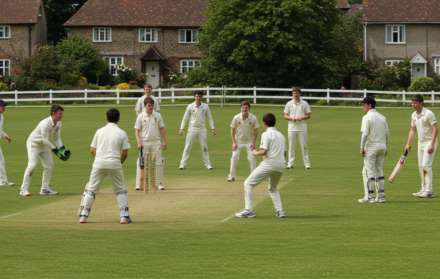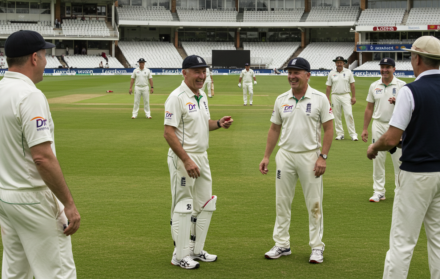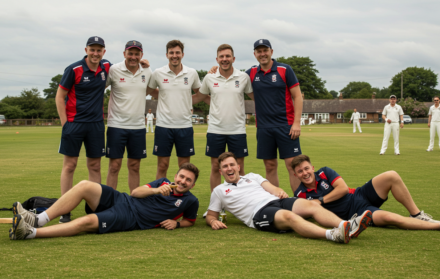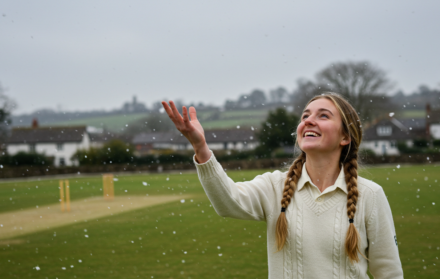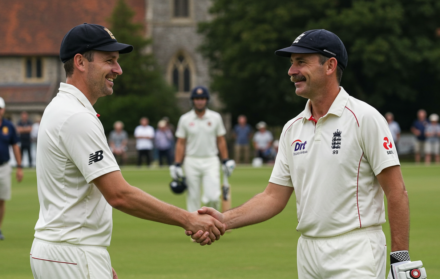
How Village Cricket Builds Friendship
Village cricket isn’t just about chasing runs or arguing over dodgy umpiring decisions. It’s about the friendships that form quietly on the boundary line, over lukewarm tea and grass-stained trousers. Teams are stitched together with more than batting orders — they’re built from years of shared effort, small traditions, and countless inside jokes that make no sense to outsiders.
Where else would a 17-year-old fast bowler and a 62-year-old groundsman end up laughing side-by-side after a particularly shocking dropped catch? Village cricket wipes away age, occupation, and background. It doesn’t matter whether you’re a surgeon, a student, or semi-retired from competitive tiddlywinks — if you can hold a bat or at least attempt to chase a ball, you’re in.
It’s a perfect example of how village cricket builds friendship in ways that few other activities can — effortlessly, across generations, with no need for anything flash or formal. The friendships forged here don’t rely on constant contact or Instagram-worthy brunches.
They’re quieter, sturdier. Years down the line, you’ll bump into a teammate in a motorway service station and feel like no time has passed at all. Village cricket builds these kinds of bonds — effortless, lasting, and stitched together by muddy whites, chaotic Sunday fixtures, and a very questionable shared love for sport.
1. You Spend More Time Waiting Than Playing
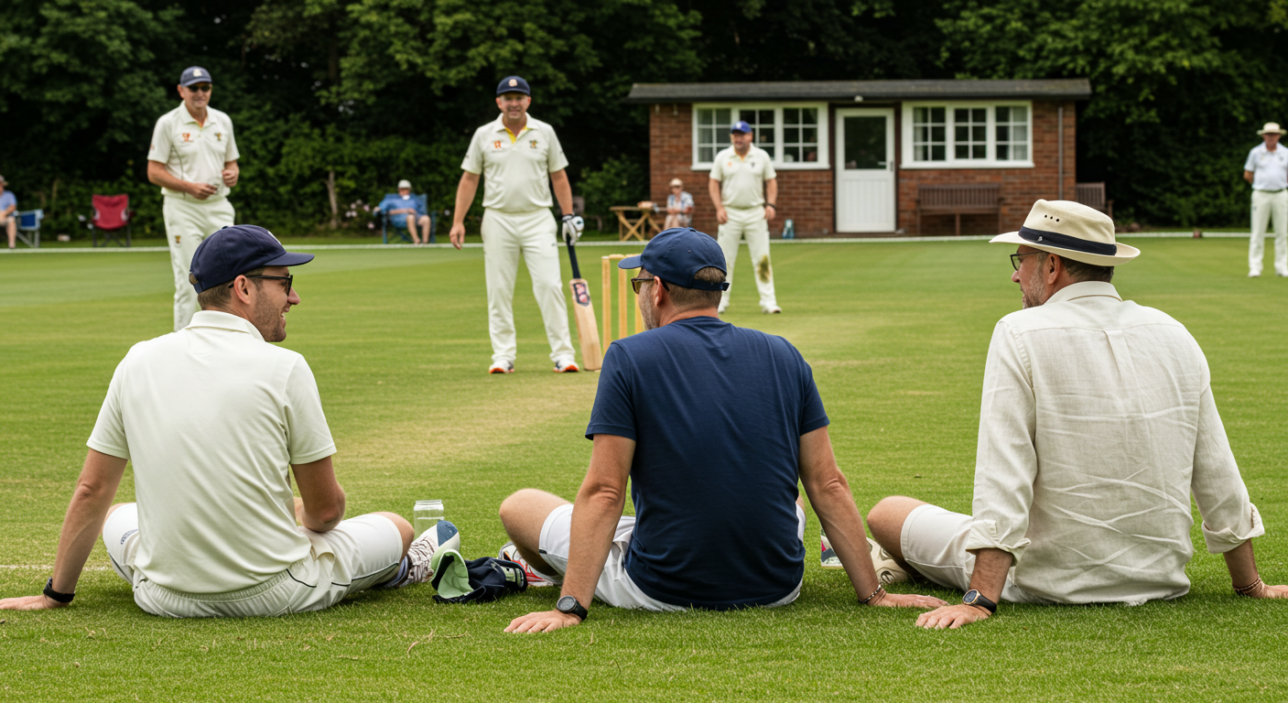
If patience is a virtue, then village cricketers are saints. Hours can pass before you even get to pad up, especially if you’re batting somewhere between number 8 and
“don’t worry mate, you probably won’t get a go.”
It’s during these long spells of doing absolutely nothing that friendships start to form.
You find yourself stuck on a bench with Dave from the next village over — a man you only know through the medium of cricket whites and bacon sandwiches. One minute you’re discussing the cloud cover; ten minutes later you’re hearing about the time he accidentally proposed to his wife at a Little Chef.
Waiting around becomes its own social event. It’s when the teasing starts, when advice (both helpful and wildly unhelpful) gets dished out, when you start offering up your life story simply because there’s nothing better to do. Some of the strongest bonds aren’t made on the pitch — they’re made on the sidelines, waiting, laughing, sharing crisps, and swapping hopeless match predictions.
In village cricket, your batting average might be terrible, but your average number of new mates per season? Through the roof.
2. Shared Triumphs (and Disasters) Stick Forever
Winning a game is brilliant, of course. But somehow, it’s the disasters that linger longer — and they’re twice as funny when you’ve lived them together.
Nobody forgets the day your best batsman got run out without facing a ball because he tripped over a molehill. Or the time the entire team spent an hour searching a field for a lost ball, only to realise it was wedged in someone’s back pocket. These small calamities become folklore, retold at every post-match drink for years to come.
Take the great scoreboard collapse of 2017 in Upper Sniddleton. Mid-innings, a gust of wind flattened the scoreboard, three deckchairs, and poor Malcolm (who still insists he caught the 7-Up bottle one-handed). Did they lose the match? Absolutely. But nobody cared — because by the end of the afternoon, they had a story that would bind them tighter than any league trophy ever could.
Victory is sweet, but shared disaster is the glue that keeps friendships hilariously, stubbornly stuck together. In village cricket, failure is funny, success is fleeting — but the people you laugh (and lose) with are unforgettable.
3. You Learn to Rely on Each Other (Even When You Probably Shouldn’t)
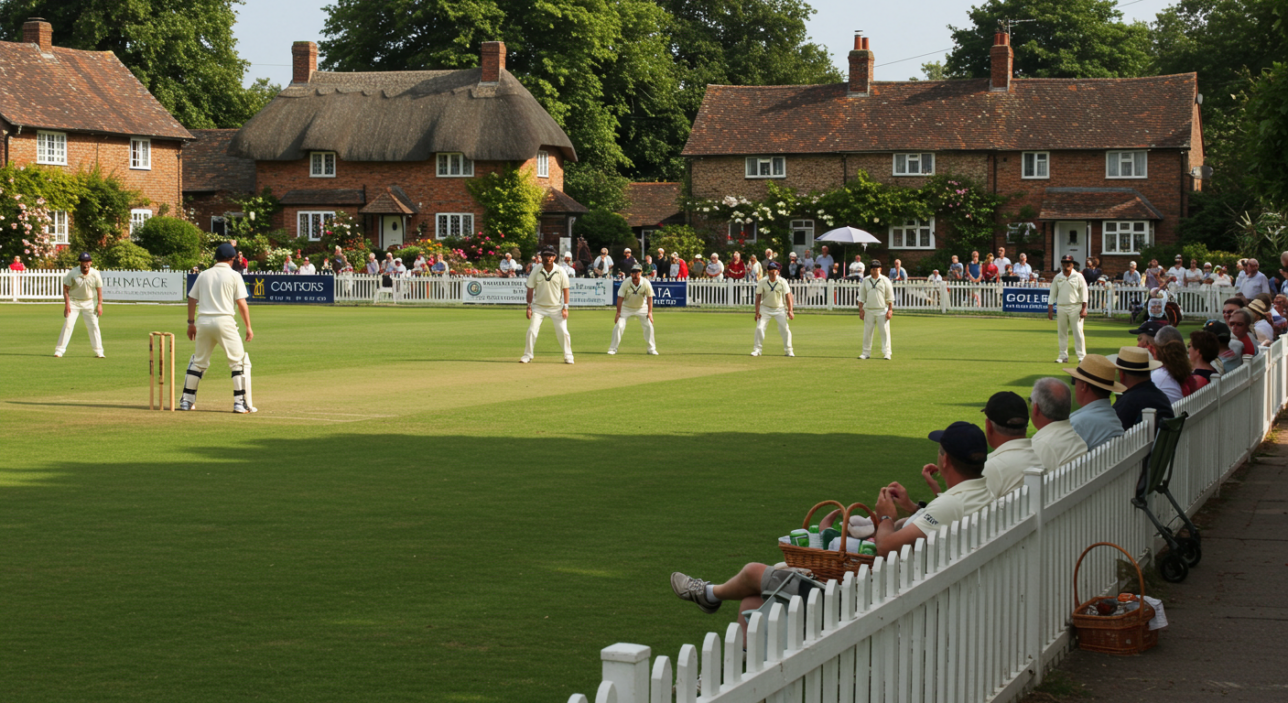
In village cricket, trusting your teammates isn’t optional — it’s survival. Whether it’s relying on someone to bring the spare stumps (which they’ve definitely forgotten), or trusting that your partner won’t run you out on a suicidal second run, there’s a constant dance of blind optimism.
There’s no HR department, no official reprimands. If Rob forgets the kit bag for the third match in a row, you don’t fire him — you tease him mercilessly and lend him your spare cricket bat (which, incidentally, has a suspicious crack down the middle).
Friendship in village cricket is built on these small, messy moments of mutual reliance. You field at cow corner for half the game because Steve’s back has gone. You bowl the last over not because you’re the best, but because everyone else is too hungover. You trust — even when experience tells you you probably shouldn’t — and somehow, it all pulls the team together.
Relying on each other, through missing helmets, bad calls, and vanishing opening batsmen, teaches a kind of loyalty that sticks. Village cricket mates don’t just turn up for the good times — they’re the ones who’ll still be laughing with you after you’ve been hit for 26 runs in an over.
4. Teas, Tents, and Terrible Karaoke Nights
Friendship doesn’t just happen between overs — it’s cemented after the game when the bats are packed away and the sandwiches come out. The social side of village cricket is where the real magic happens.
One afternoon of cricket can turn into an entire evening of slightly burnt barbecues, wildly competitive pub quizzes, and ill-advised karaoke renditions of “Sweet Caroline” by three blokes still wearing grass-stained whites. It’s in these after-match moments — sitting under leaking marquees or jammed into village halls — that acquaintances become real mates.
Every club has its own traditions. At West Widdlecombe, the man of the match is forced to wear a fluorescent pink hat to the pub. In Lower Snatchley, missing an easy catch means buying the first round (resulting in some suspiciously theatrical drops). These rituals aren’t just silly — they build bonds.
Nobody at these evenings cares who top-scored or bowled a hat-trick. What matters is who can produce the worst joke, who can remember the name of the umpire’s dog, and who’s going to volunteer to help fix the broken sightscreen next weekend. Village cricket friendships aren’t born under pressure — they’re grown slowly, with a lot of laughter, a little bit of beer, and a healthy tolerance for off-key singing.
5. You Celebrate the Small Wins (Because Someone Has To)
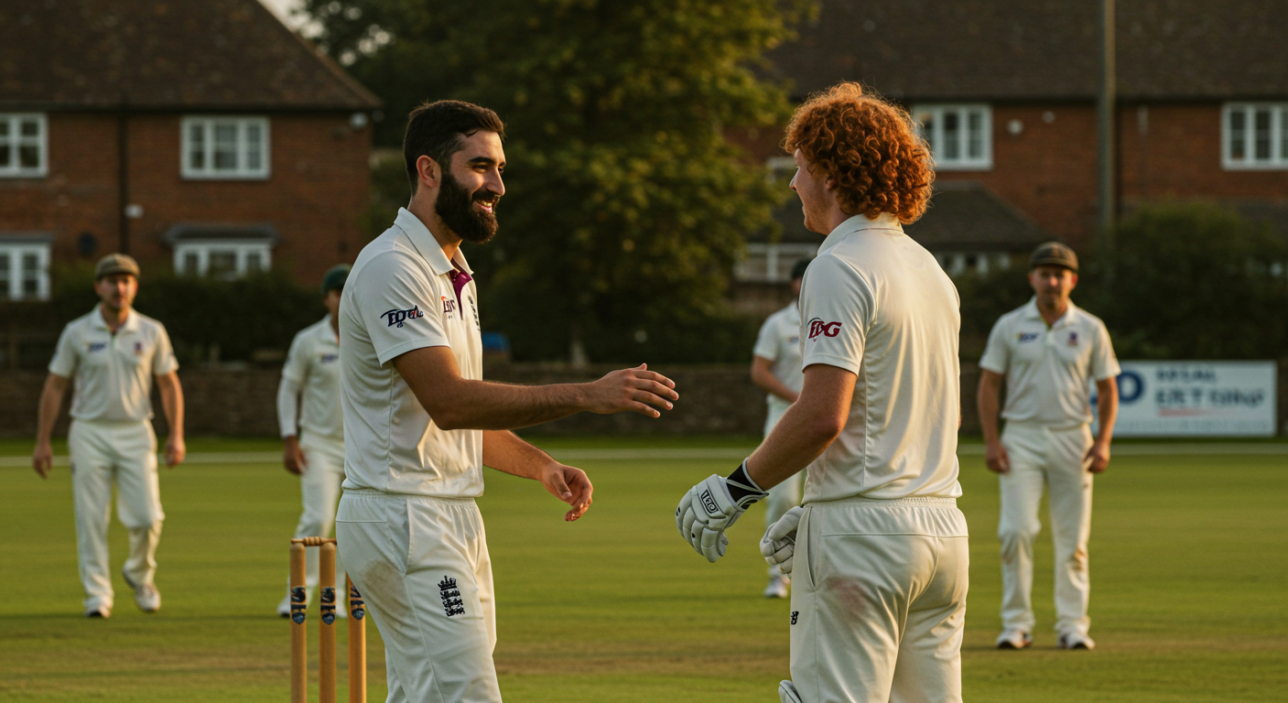
In professional sport, it’s all about lifting trophies and securing lucrative sponsorships. In village cricket, the celebrations are a little… smaller. A cleanly taken catch? Pub drinks all round. Someone finally remembers to bring a new box of balls? Standing ovation. A player turns up on time and with both shoes? A minor miracle worth commemorating.
It’s in these tiny victories that friendships are stitched together. You’re not just teammates — you’re cheerleaders for the mundane, witnesses to each other’s micro-achievements. Nobody outside the team would understand why the fact that Martin managed a textbook forward defensive is worth three days of gloating. But inside the team, it’s a moment of pure joy.
The bond comes from noticing and celebrating these details. You learn each other’s quirks, bad habits, and tiny improvements. One summer you’re teasing Gary because he can’t hit a ball off the square; by the next, you’re mobbing him when he finally clatters a boundary through cover.
In village cricket, friendship isn’t built on glory. It’s built on clapping the guy who bowled seven wides but somehow snuck in one brilliant yorker. It’s about recognising the effort, not just the outcome — and making sure nobody feels invisible, no matter how many ducks they rack up.
6. Injuries, Ice Packs, and In-Jokes
Village cricketers don’t retire because they’ve had enough — they retire when their knees send a final, non-negotiable letter of resignation. Until then, every pulled hamstring, sunburnt nose, and jammed finger becomes part of the running commentary that stitches a team together.
It’s a peculiar sort of bonding, hearing about Keith’s dodgy rotator cuff for the 17th time, or watching Dave strap his entire body with tape before he can bowl a single over. Injuries become folklore. “Remember when Paul pulled a calf muscle appealing for an LBW?” Cue laughter, ice packs, and gentle mockery lasting well into the winter nets.
But it’s the in-jokes that really seal the deal. Every team has them: odd nicknames nobody can quite explain (“Why is Andy called Spanner again?”); endless callbacks to long-forgotten match disasters; a collective groan every time Pete steps up to bat because of That One Time He Swung So Hard He Fell Over.
Friendship is repetition — the same jokes, the same injuries, the same good-natured teasing season after season. And in village cricket, that repetition weaves a safety net where everyone feels known, remembered, and, in some daft way, celebrated.
7. You Build a History Together — One Match at a Time
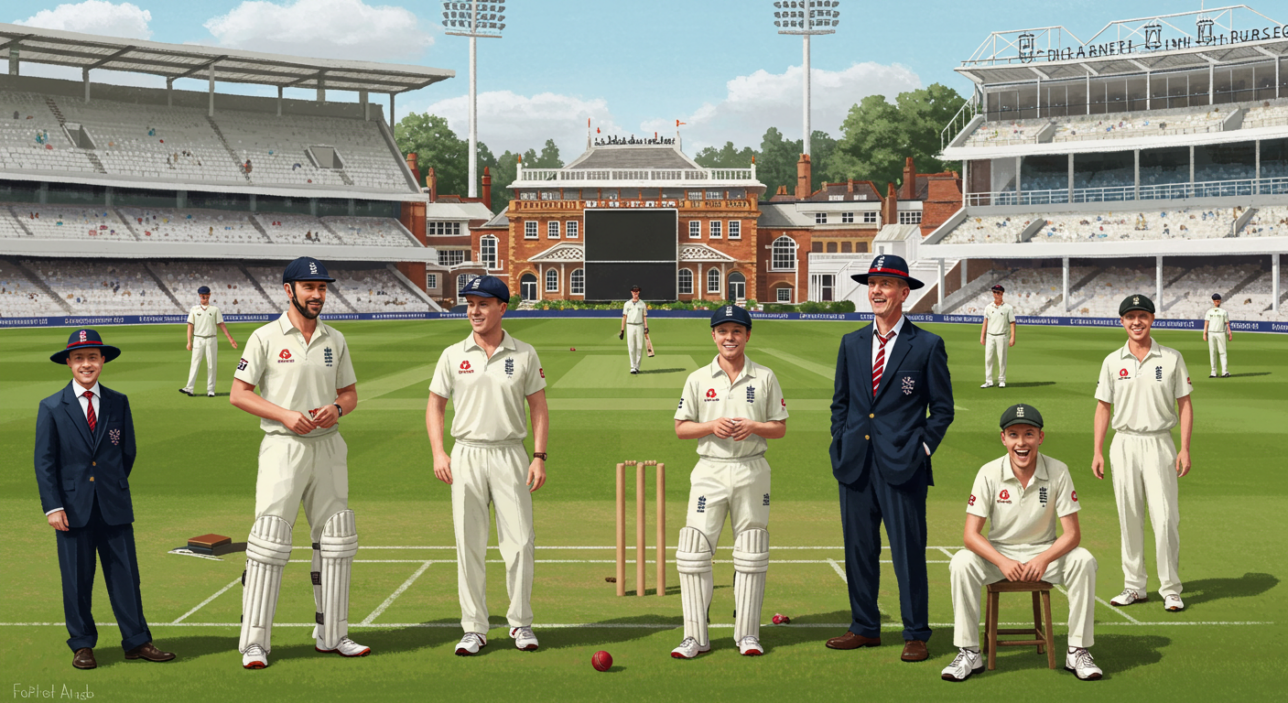
Season after season, the memories start to pile up. Not the big, flashy moments, but the little ones: the first six someone ever hit, the game played entirely in sideways rain, the time three fielders collided trying to catch the same ball and somehow all claimed credit.
Village cricket friendships aren’t built overnight — they’re layered like the old scorebooks gathering dust in the pavilion. You remember who was there the day the pavilion roof started leaking mid-tea. You remember who stitched up a collapsing sight screen with string and hope. You remember who volunteered to field when half the team had given up and wandered off for ice creams.
Each match adds another inside joke, another shared reference point, another reason you’ll always nod knowingly across the pub when the word “Sniddleton” is mentioned (even if nobody else has a clue why).
It’s not just about playing a sport — it’s about writing a shared story, one slow, funny, occasionally shambolic chapter at a time. And when you look back years later, it’s never the scorelines you remember. It’s the people you remembered them with.
Conclusion: How Village Cricket Builds Friendship
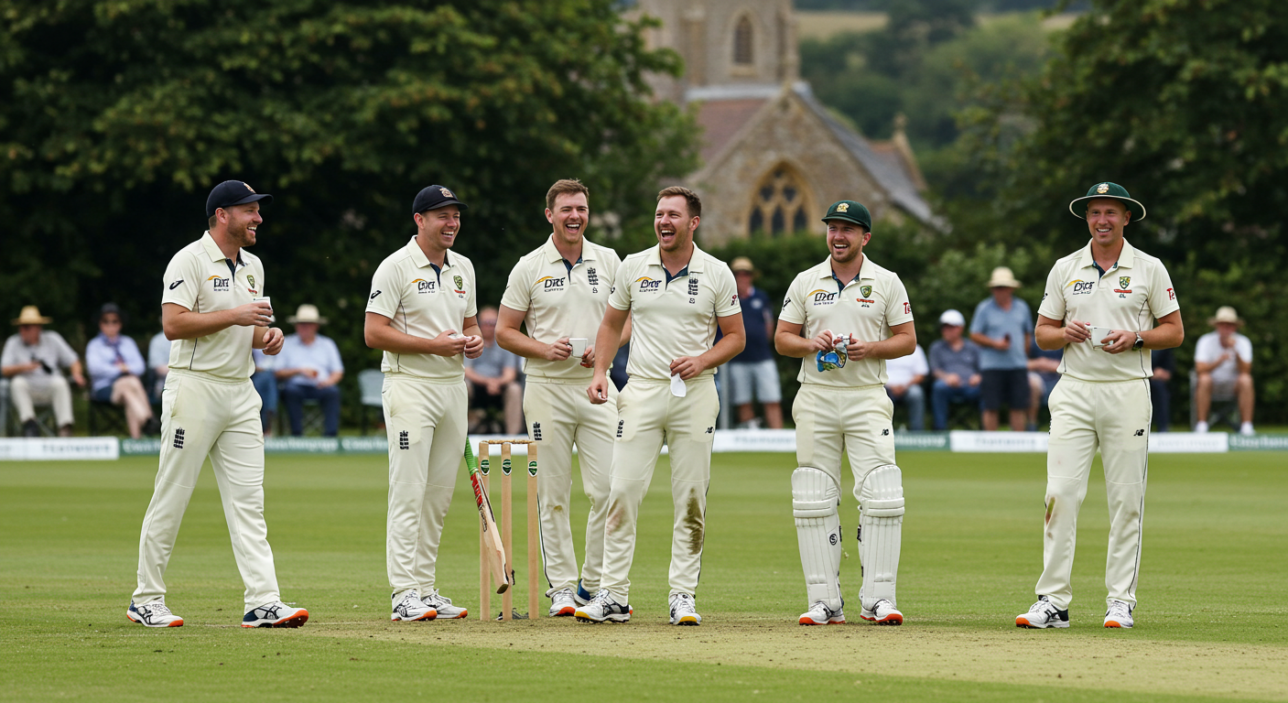
In the end, nobody really cares how many matches were won or how many wickets were taken. What matters is who stood with you when you dropped a sitter, who shared their sandwiches with you when you forgot yours, who still jokes about that time you were clean bowled by a ten-year-old leg-spinner.
Village cricket friendships are different. They’re slower to form but harder to break. They’re rooted in shared experiences that are too ridiculous, too minor, and too lovely for anyone else to fully understand. It’s not about Instagram posts or WhatsApp groups — it’s about the steady knowledge that, somewhere, you’ve got a group of people who saw you at your most chaotic and still laughed with you rather than at you.
In a world obsessed with instant connection, village cricket offers something rarer and richer: friendships that are earned, match after match, pint after pint, terrible shot after terrible shot. Friendships that, once built, don’t need constant attention to survive.
Every dropped catch, every sunburned nose, every homemade tea break has a purpose. They’re the scaffolding that holds up something far more important than any silverware ever could: the friendships that outlive the final overs, the battered kit bags, and the fading chalk marks on the square.
That’s why village cricket matters — and why the friendships it creates are among the best you’ll ever make.
